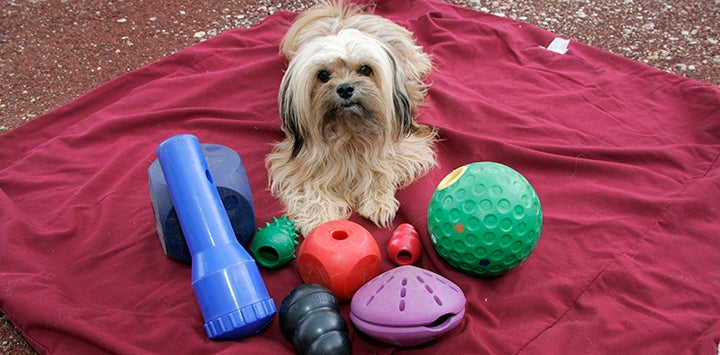
Positive Reinforcement: Training with Praise and Rewards
By Sherry Woodard
Positive reinforcement is the most effective and humane way to train animals. The basic principle is to reward a desired behavior with something pleasant. As with so many things, correct timing is essential. To get the animal to associate the reward with the correct behavior, the treat or praise must be delivered immediately. Consistency is also essential – always reward the desired behavior and don’t ever reward undesired behavior.
The reward for good behavior can be a favorite toy, a game, petting, praise, or food treats. Most dogs and cats will work for food, so food is the most common training reward. Use small pieces of soft treats that don’t require a lot of chewing, so that you don’t lose the animal’s focus on the task at hand. Offer praise and food rewards every time a dog is learning a new behavior. After the dog responds consistently to a cue, you can praise him without offering any treats.
Your dog will learn cues better if everyone in your household uses the same ones. Some commonly used cues are sit, stay, down (used when you want your dog to lay down), off (used when a dog has jumped up on someone), and come.
Keep training sessions short – you want training to be fun for both you and your pet. Dogs are very sensitive to the tone of your voice, so if you’re in a bad mood, put off the training session until you can enjoy the time spent with your dog.
Remember, to remain well-behaved, all dogs need regular exercise and social interaction. To keep them socially acceptable, they need to socialize. After some basic training, your dog will politely interact with most humans, whether they are guests in your home or strangers in the park. If you want more information about humane methods of training, here are some books I recommend:
Before You Get Your Puppy by Dr. Ian Dunbar
Dunbar, a veterinarian and animal behaviorist, covers what he calls the three “developmental deadlines” to meet before you get your puppy: completing your education about puppies, knowing how to assess your prospective puppy’s progress and instituting errorless house-training.
After You Get Your Puppy by Dr. Ian Dunbar
In this book, Dunbar covers the three “developmental deadlines” to meet after you get your puppy: socializing your puppy to people, teaching bite inhibition and continuing socialization in the world at large.
Pet Behavior Protocols by Suzanne Hetts
This book is for veterinary professionals, shelter staff, breeders, trainers, and animal control agents who want to help people find sensible solutions to their pet behavior problems.
Don’t Shoot the Dog! The New Art of Teaching and Training by Karen Pryor
Pryor clearly explains the underlying principles of behavioral training and uses numerous examples to show how to achieve your training objectives through positive reinforcement. She also has a website on clicker training.
Dogs Are from Neptune by Jean Donaldson
Donaldson draws from real cases to provide clear, step-by-step advice for troubleshooting dog behavior problems – ranging from obedience stumpers like pulling on lead to serious issues like biting and fighting.
The Culture Clash by Jean Donaldson
Donaldson presents a revolutionary new way of understanding the relationship between humans and dogs.
Outwitting Dogs: Revolutionary Techniques for Dog Training That Work by Terry Ryan
Ryan draws on her 25 years of hands-on experience to help people understand dogs, train dogs, and solve dog behavior problems using kinder, gentler methods.
Dog-Friendly Dog Training by Andrea Arden
This is a great book for beginners.
Love Has No Age Limit: Welcoming an Adopted Dog into Your Home by Patricia McConnell and Karen London
This book helps ease the transition from shelter to home.